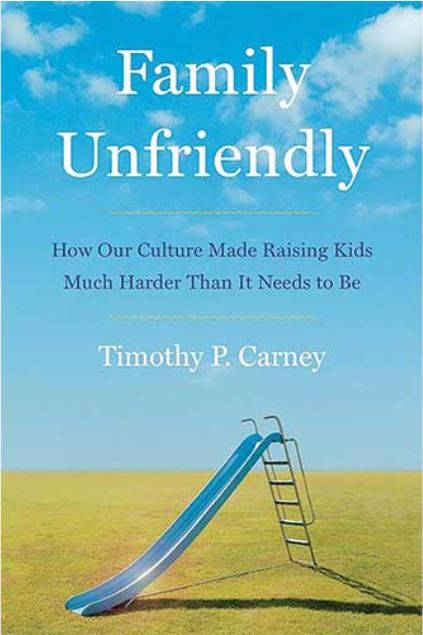
A Compelling Case for More Kids
By William P. Hoar
A key theme of this book is uncommon for this day and age. The author (and his wife — who both came from larger-than-average families and are themselves the parents of six children) makes the seemingly incongruous case that the best way to make childhood and parenting less stressful and happier is to have more children, not fewer.
Before you dismiss the premise as being made by someone with an investment in chaos, be aware that his reality is not unhinged. The book does use the term “messy” more than once. The author knows, as do many of us, that on the sunny side, we see how children brighten up a room; on the true-to-life side, we understand that the extra radiance might well be because the kids forgot to turn off the lights.
Is this encouraging message flying against the prevailing winds? Sure. That’s one of the reasons the journey is so difficult. Along the way, there are, for example, New York Times headlines that tell the establishment line all by themselves: “Would Human Extinction Be a Tragedy?” and “To Breed or Not to Breed?” As a result, our countrymen are instilled with fears that project a dim future. Accordingly, “By a two-to-one margin,” we read, “Americans believe that our standard of living will be worse a generation from now. Millennials and Generation Z are even more pessimistic.”
If our culture makes the raising of children so difficult, we should not be surprised there are fewer of them. The birthrate in this country “has been falling steadily since 2008,” according to Family Unfriendly: How Our Culture Made Raising Kids Much Harder Than It Needs to Be, “and there are now fewer children in America than there were a decade ago.” We are “in the midst of a decades-long Baby Bust.”
Playing Is Supposed to Be Fun
Another target is the goal of intensive parenting, seeking “quality over quantity.” Timothy Carney, author of Family Unfriendly,doesn’t buy that. (Carney has been a columnist, author, and editor for years. He writes for the Washington Examiner and is a senior fellow at the American Enterprise Institute.) That doesn’t mean, he stresses, that the Carney children don’t have plenty of organized activities.
However, Carney has been disabused of what he calls the “Travel Team Trap,” meaning disproportionate involvement in expensive distant baseball teams or theater or other overly extravagant interests. He also warns against “overparenting,” sometimes called “helicoptering.”
That is an example of the “culture” that can be overwhelming (as well as lead to fewer children). Writes Carney:
Our culture teaches parents that you need to hone your daughters and sons into high achievers at a young age, and that you have to give them every advantage possible: tutors, lessons, equipment, private training. It takes all of your money and your time.
Perhaps you’ve seen this in practice. One unfortunate side effect for many children is “burnout” from an activity that used to bring pleasure. Carney emphasizes that he relishes the achievements of his children, but also enjoys the absurd games they create for themselves in the front yard.
Purposely, some chapter names are teases, meant to be provocative. When readers first see “Have Lower Ambitions for Your Kids,” for example, or “Hey, Parents, Leave Your Kids Alone,” they might do a double take. After examining the rationales, though, they find that what is being touted is, essentially, a balanced life and more common sense.
Simple play of late seems to be an endangered activity. If you are of a certain age, you might recall pick-up games of baseball, football, or other sports. Jumping rope used to be a thing. Maybe you remember walking or biking with buddies somewhere, anywhere, just for fun. Nowadays, that could lead to an official report of an unsupervised child.
A number of obstacles relate to how suburbs are now built. As Family Unfriendly observes, not only are there fewer kids taking long walks, “but fewer even walk to the corner store, the ballfields, or school. In 1969, more than 40 percent of American school kids walked or biked to school. By 2016, that number was about 10 percent. American teenagers walk less and less every year.” Rather, parents of late have become unpaid cabbies, as Carney puts it.
Not all communities have the same issues. We get to see some different communities in Family Unfriendly, including the largely Mormon Rexburg, Idaho, where in the surrounding county there are nearly twice as many births per woman of childbearing age than in the average U.S. county.
Then there is the Kemp Mill area in Silver Spring, Maryland, which is the most Jewish neighborhood in the general D.C. area and on holidays and Saturdays is (as the book well describes) different from the other suburban areas in the county. The author is not exaggerating. Here’s a bit more about Kemp Mill:
On Shabbos [Sabbath], at certain times of day, you’ll see families — not infrequently families of six, seven, or eight — all walking to one of the Orthodox synagogues in Kemp Mill. At other times, you’ll see kids of all ages, wandering free, often in small posses.
Quoted is one man who came to the neighborhood in 1978: “When people move in here,” he says, “they never leave.”
Where the Birthrate Is Rising
Religion plays a vital role in Family Unfriendly, as the author examines various parts of this country as well as locations overseas, particularly Israel. Cited are researchers who have found that “religiosity predicts fecundity.”
Israel helps make the author’s points, showing, for example, that one need not choose between gender inequality and replacement-level fertility. Nor does a solution to the Baby Bust have to be a huge welfare state. As he puts it, “Israel is a very educated population with high gender equality and below-average welfare spending. Yet Israel, by far, has the highest birthrate among wealthy countries.” Israel is about twice as fecund as Europe, and has many more babies per capita than the U.S. — and it’s not just because of the ultra-Orthodox. Indeed, as we read, the birthrate of even secular Jews is higher in Israel than any European country.
 A section on “America’s Zion” delves into communities in Utah and Idaho with many members of the Church of Jesus Christ of Latter-Day Saints. The demographics are intriguing. It is, we read, “not just Mormons who have lots of kids out there: Catholics in Utah have more kids than Catholics anywhere else.”
A section on “America’s Zion” delves into communities in Utah and Idaho with many members of the Church of Jesus Christ of Latter-Day Saints. The demographics are intriguing. It is, we read, “not just Mormons who have lots of kids out there: Catholics in Utah have more kids than Catholics anywhere else.”
Big families often beget big families. That’s what happened to the Carneys: “My children by age twelve have all cradled babies to sleep, changed diapers, and mixed a bottle of formula. When caring for a younger sibling or cousin, babysitting within our family circle, or just hanging around a backyard barbecue or Sunday Mass, our children grow up surrounded by babies.”
Elsewhere, however, the story is different: While 90 percent of the United States described itself as Christian in 1990, that number fell to 63 percent by 2020. Other religions didn’t fill the void. About 30 percent in 2020 were “unaffiliated” — “easily the fastest-growing ‘religious’ group in the country.”
Are Children Too Expensive?
While not paramount, economics is not ignored in Family Unfriendly. Young people may be skeptical of cited government statistics (the author agrees it is a complicated situation). Nonetheless, the book says (repeatedly) that the cost of raising children can’t excuse “the decrease of making children since 2007 or since 1980 because the cost of raising children hasn’t really gone up” if increased wages are taken into effect. But statistics are somewhat like witnesses — they can testify for either side. Carney does acknowledge how childcare expenses have terrified young people, but he also offers ameliorating perspectives.
But how about ongoing homeownership costs and other essentials that are skyrocketing? Americans give their budgets more credence than what Washington might say. Indeed, the left-wing Washington Post just conceded in a data-heavy report, “Move over, millennials. There’s a new generation being walloped by the economy. Generation Z has been disproportionately pummeled by rising prices, higher housing costs, larger student loan balances and more overall debt than the millennials before them.” Family Unfriendly does have strategies to combat such situations, but it is still hard to overcome the widespread feeling that “kids are too expensive.” Indeed, the same Post piece concedes that “The financial difficulties burdening Gen Z could help explain President Biden’s challenges in connecting with younger voters, who cite inflation as their top concern.”
We are also reminded in Family Unfriendly how fear of disastrous climate change and guilt have been drilled into millennials and Gen Z. “From every direction comes the message: We cause harm. We are not good.”(Emphasis in original.)
With a topic with such a wide scope, there are bound to be areas of agreement as well as spots where readers might be unconvinced. Throughout, however, Carney’s writing is comfortable, not confrontational. His story is a personal one as well as one for a larger audience. He does show off his erudition in spots, making it fun when you confront, say, a well-known boxer described as “contemporary philosopher Mike Tyson,” with his famous maxim, “Everyone has a plan till they get punched in the mouth.”
“Iron Mike’s philosophy, channeling Socrates’ definition of wisdom and David Hume’s notion of epistemic humility,” Carney writes (presumably with a bit of a smile), “has been indispensable in our two decades as parents.” And many parents, old and new, do know that the best thing they can spend on their children is time.
However, what is all too often blared is a quite different narrative. Cited are noxious toxins such as this (from feminist attorney and writer Jill Filipovic): “Having children is one of the worst things you can do for the planet.” Human life itself, insists this death wish, is wicked.
With limited space, we can only hint at what else is in this family-friendly volume: an examination of the so-called Child Penalty in women’s professional lives; the ramifications of technology in the screen generation, dubbed iGen; dating practices today; effects of fewer children on Social Security; virtues of community; what is “demanded” these days of parents; and an assessment of “civilizational sadness” (and the fact that when it shows up, so too does the Baby Bust). We are offered a goodly amount of circumstantial evidence that, “Demographically, ideologically, and geographically, sadness and infecundity go together.”
If you think that the world has gone awry, or more likely whenever you are sure that is the case, this volume offers a corrective. Comb out the tangles of the past. It is when these doubts arise that “we need the unconditional, all-needing love of a little child to remind us, with a smile or even simply a gaze, that we are good.”
Published with permission of thenewamerican.com